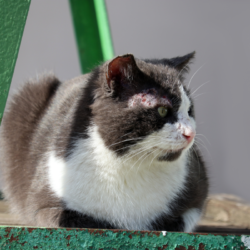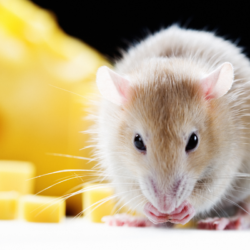Zoonoses, or diseases that can be transmitted from animals to humans, are a major public health issue. Of particular concern is Streptococcus suis, a bacterium mainly found in pigs. This article takes an in-depth look at this bacterium, how it is transmitted, the symptoms it causes in animals and humans, and the means of diagnosis, treatment and prevention available.
What infectious agent is responsible?
Streptococcus suis is a Gram-positive coccoid bacterium belonging to the genus Streptococcus. This bacterium is aerotolerant and encapsulated, giving it relative resistance in the environment. There are currently 35 serotypes, although some have been reclassified as other species. Serotype 2 is the most prevalent and the most pathogenic for pigs and humans.
This bacterium has distinct morphological and biological characteristics. S. suis is a Gram-positive cocci, which means that it appears purple when stained with Gram stain, due to the structure of its cell wall. It occurs in chains or pairs. Its ability to survive in facultative anaerobic conditions allows it to colonise a variety of environments, including animal tissues and contaminated environmental surfaces.
S. suis is mainly found in pigs and wild boar, but can also persist in contaminated environments, especially at low temperatures. Sensitive to many disinfectants such as sodium hypochlorite and ethanol, this bacterium is inactivated by moist and dry heat. This ability to survive in the environment, combined with its sensitivity to disinfectants, guides biosecurity practices in pig farms and meat processing facilities.
The virulence factors of S. suis are not yet well understood. The bacterial capsule is essential for virulence, as it protects the bacteria from phagocytosis by the host immune system. However, other structures such as extracellular proteins and haemolysins also play a crucial role. Proteins such as muramidase-released protein (MRP), extracellular factor (EF) and suilysin (a haemolysin) are associated with virulence in European and Asian strains, but not necessarily in North American strains.
How does this disease manifest itself in animals?
The disease caused by Streptococcus suis mainly affects pigs and wild boar. The bacteria often colonise the respiratory tract of pigs without causing any symptoms. Transmission is mainly via nasopharyngeal secretions from infected pigs, but can also occur via the environment contaminated by faeces or dust.
Pigs become infected as soon as they are born, often through contact with their mother’s nasopharyngeal secretions or through the contaminated environment. Piglets born to infected mothers become infected quickly after birth. The bacterium persists in the farm environment, especially in the presence of factors that favour bacterial survival, such as low temperatures.
Stress, overcrowding, transport and poor rearing conditions all favour the appearance of symptoms in pigs.S. suis infections are particularly common in high-density farms. Symptoms include pneumonia, meningitis and endocarditis, especially in pigs aged between 3 and 14 weeks. Factors such as stress, temperature changes and poor ventilation can exacerbate the onset of clinical signs.
Clinical forms of infection vary depending on the bacterial strain and the farm. Acute infections often manifest as signs of meningitis such as incoordination, paralysis, tremors and convulsions, often leading to death. Other common conditions include arthritis and endocarditis. Arthritis manifests itself as swollen and painful joints, mainly affecting young piglets. Endocarditis is more common in fattening pigs and can lead to heart failure.
Studies have shown that S. suis can also cause interstitial and fibrinous pneumonia in piglets. This form of pneumonia is often observed in experimental infection settings and can be used to model the pathogenesis of S. suis infection. Respiratory symptoms, although less common than neurological and joint symptoms, may include cough, dyspnoea and respiratory distress.
How is it transmitted?
Streptococcus suis is transmitted mainly via the skin, often by accidental inoculation (sting, cut) or soiling of skin lesions. The respiratory and digestive tracts are not excluded. Transmission to humans is rare and mainly occurs among people in direct contact with pigs or their meat, such as farmers, vets and slaughterhouse workers.
The disease is very rare worldwide, including in France, with limited recent outbreaks in China. People at risk include those working in contact with pigs or their meat, in particular pig farmers, vets, abattoir workers and butchers. Gamekeepers handling wild boar are also at risk.
The disease is transmitted to humans by contamination of skin wounds or mucous membranes by the blood or secretions of infected pigs. In South-East Asia, the consumption of raw pig meat or blood is a common route of transmission. The disease is often under-diagnosed and under-reported in many countries, making its prevalence difficult to estimate accurately.
In the workplace, it mainly affects workers who come into direct contact with infected pigs or their meat (farmers, vets, butchers, etc.). Symptomatic pigs present a higher risk of transmission.
In Europe, S. suis is mainly transmitted by percutaneous exposure to biological fluids, by accidental inoculation or by soiling of skin lesions during direct contact with infected pigs or pork. Unprotected wounds are more likely to lead to infection. The route of entry is sometimes undetectable.
A few cases of infection via the respiratory or digestive tract remain possible, although they have not been formally confirmed. In Asia, transmission is most common through the consumption of raw or undercooked pork.
To date, no cases of human-to-human transmission have been described.
What are the symptoms of this infection in humans?
The incubation period for Streptococcus suis infection in humans generally lasts a few days. The most common manifestation is meningitis, often accompanied by sequelae such as deafness. Other possible complications include arthritis, septicaemia and endocarditis, which can sometimes be fatal.
Handling pork sometimes causes skin lesions in some people. Serotype 2 is the main cause of human cases, although other serotypes may also be involved. Meningitis caused by S. suis can lead to loss of balance and deafness, due to damage to the eighth cranial nerve.
Common symptoms include fever, chills and arthralgia. Other clinical forms include sepsis, arthritis, spondylodiscitis and endocarditis. Toxic-infectious shock and purpura fulminans are serious but rare complications. The fatality rate varies between 7% and 13%, sometimes reaching over 20% in South-East Asia.
Signs of meningitis include headache, stiff neck and photophobia. Signs of septicaemia include petechiae, hypotension and tachycardia. Arthritis can cause joint pain and reduced mobility. Early detection and appropriate treatment are crucial to minimise complications and mortality.
How is it diagnosed?
Diagnosis of Streptococcus suis infection is based on a series of rigorous procedures designed to isolate and identify the bacteria responsible for the infection. These procedures include biological samples and specialised laboratory tests.
Biological samples are essential to confirm the presence of S. suis. Commonly used samples include:
- Blood cultures: Blood samples are taken to detect the bacteria in cases of septicaemia.
- Cerebrospinal fluid (CSF): Used mainly to diagnose meningitis, this sample is taken by lumbar puncture.
- Joint fluid: In the case of arthritis, a synovial fluid sample is taken to look for the presence of bone marrow.
Samples are cultured on appropriate media to isolate S. suis. Bacterial colonies are then identified by their morphological and biochemical characteristics. Capsular serotyping determines the specific serotype of the bacteria, a crucial aspect in understanding the epidemiology of the infection. Specialist laboratories, such as national reference centres (NRCs) and veterinary laboratories, generally carry out this stage.
Polymerase chain reaction (PCR) tests offer a rapid and accurate method for detecting the presence of S. suis in clinical samples. PCR allows specific amplification of bacterial DNA segments, facilitating rapid and reliable identification of the bacteria.
Clinical signs of infection, such as meningitis, septicaemia and arthritis, also play a key role in diagnosis. Clinicians need to be alert to characteristic symptoms to guide appropriate sampling and diagnostic testing.
Diagnosis of S. suis infection relies on a combination of biological sampling, culture, PCR testing and assessment of clinical signs. Rapid and accurate identification is crucial for initiating appropriate treatment.
What is the appropriate treatment?
The mainstay of treatment for Streptococcus suis infection is the use of antibiotics, in combination with other therapeutic measures to manage symptoms and complications.
Beta-lactam antibiotics, particularly penicillin and ceftriaxone, are the first-line antibiotics used against S. suis. These antibiotics are generally effective against the majority of strains of the bacterium. Vancomycin is an important alternative, especially in cases of resistance or allergy to beta-lactam antibiotics. The effectiveness of these antibiotics is due to their ability to inhibit the synthesis of the bacterial cell wall. This leads to the lysis and death of bacterial cells.
Resistance to tetracyclines and macrolides is frequently observed in S. suis strains. Susceptibility to chloramphenicol, aminoglycosides and fluoroquinolones varies, requiring antibiotic susceptibility testing in each case to determine the most appropriate treatment.
The use of corticosteroids in the treatment of S. suis meningitis is sometimes debated. Corticosteroids reduce inflammation, thereby limiting the risk of neurological complications such as deafness. However, clinicians must carefully assess their use on a case-by-case basis.
Doctors administer the antibiotic treatment in high doses over a prolonged period. This ensures complete eradication of the infection and prevents sequelae. Patients often need to receive intravenous antibiotics at the start of treatment, especially in cases of meningitis or septicaemia, followed by oral antibiotics when the clinical condition improves.
People with an increased risk of developing a severe form of the disease, such as those suffering from diabetes, cirrhosis of the liver or undergoing immunosuppressive treatment, require particular care. These patients should be monitored closely for signs of complications and treatment adjusted accordingly.
What preventive measures are available?
Prevention of Streptococcus suis infection relies on a combination of rigorous hygiene measures, appropriate management practices on pig farms, and individual precautions for those who come into contact with pigs or their meat.
Maintaining optimal husbandry conditions is crucial to reducing animal stress, as stress encourages the onset of symptoms. The following practices are essential:
- Regular cleaning and disinfection of premises and equipment. Use effective disinfectants such as sodium hypochlorite or ethanol.
- Waste management: Adequate storage of waste and animal carcasses to avoid environmental contamination.
- Animal density control: Avoid overcrowding to reduce stress and the spread of the bacteria.
Workers in contact with pigs must follow strict safety practices:
- Appropriate work clothing: Wear protective clothing, including gloves, boots and masks, to avoid direct contact with animals or their secretions.
- Personal hygiene: Wash hands frequently with soap and water, especially after handling pigs or their meat. Wounds should be cleaned, disinfected and protected with an impermeable dressing.
- Training and information
When a disease is detected on a farm, strict control measures must be implemented:
- Reinforcement of hygiene: Clean and disinfect premises and equipment more frequently.
- Wearing protective gloves and clothing: when handling sick animals, their faeces or their corpses.
- Isolate infected animals: Limit access to sick animals to prevent transmission.
- Appropriate treatment: Administer antibiotics and follow veterinary treatment protocols to reduce the bacterial load.
Some epidemiological data…
Streptococcus suis is found throughout the world, especially in areas with a high pig population. Serotypes 1 to 9 account for over 70% of isolates recovered from sick pigs.
In Thailand, Streptococcus suis infections rose by 67% in 2021 compared with the previous year. They reached 576 cases and caused 24 deaths. Epidemics are often triggered by the consumption of local dishes based on raw pork and by contact with pigs without adequate protection. In Europe, cases occur more sporadically. They are also frequently linked to occupational exposure, such as by slaughterhouse workers or pig farmers.
Worldwide reports describe more than 1,600 cases of human infection with S. suis . However, the true incidence is probably higher due to under-reporting. In China and South-East Asia, over 90% of cases are mainly due to the consumption of raw or undercooked pork. In Europe, cases are more sporadic. They are often attributed to occupational or recreational exposure, such as wild boar hunting.
Epidemics of S. suis infection frequently accompany co-infections with porcine reproductive and respiratory syndrome virus (PRRSV) and, more rarely, swine influenza virus.
Serotypes 1 to 9 include serotype 1/2, which shares antigens with serotypes 1 and 2. They account for more than 70% of bacterial isolates recovered from sick pigs. Serotype 2 is, in general, the most widespread in Europe and Asia; however, it is less important in North America, where it is the second most widespread serotype, behind serotype 1/2. Serotype 9 is the type most frequently isolated in certain European countries, such as Spain, Germany and the Netherlands.





